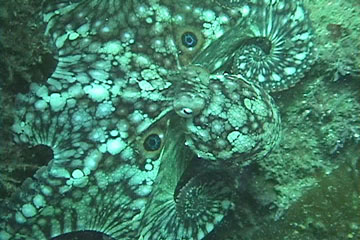
My Dive Playmate: the Fascinating Octopus

Often while diving I find myself transfixed in a small area observing the obscure marine life that form the micro-ecology of the rocky reefs in the Casino Dive Park.
This often happens when the visibility is poor and my video work is limited to close-up subjects. Last Sunday I spent much of my "bottom time" watching with great fascination a young octopus who seemed equally fascinated watching me.
There is no question that an octopus' eyes convey a real sense of intelligence, probably one reason many non-divers seem fascinated by them as well.
This little octopus was no exception. Its eyes were as expressive as the beautiful color changes noted when its mood altered (of course I'm a "sucker" for a pair of beautiful eyes!). Researchers have noted individual behavioral differences in octopi and this one, like others I've observed, seemed to reflect this with its own unique "personality."
My interest in octopi began before Catalina while I was backpacking Europe in the summer of 1968. I spent much of my time on the Greek islands where octopi are served in many of the small, family-owned restaurants (you can try them yourself at Flip's!). While free diving, I spent some of my time underwater watching these often highly amusing creatures and tried to catch them using the traditional method: bits of cloth tied to a line.
Our local two-spotted octopus is named due to the eye-like blue spots on the web of its mantle. Actually two species are present here (Octopus bimaculoides and O. bimaculatus). The first is found from San Simeon to Ensenada and the second from Santa Barbara to the southern tip of Baja and into the Gulf of California. They are almost impossible to tell apart unless you analyze the different parasites in their kidneys and some minor physical differences. Fortunately male and female octopi have no trouble telling the two species apart when it is time to mate.
During late winter and early spring, females lay up to 150,000 eggs often under rocks. The females tend their eggs for two to four months until they hatch. During this time the female reportedly does not feed and may die around the time the eggs hatch. The young spend a short time drifting in the plankton and often settle in shallow water as young. They live 2-3 years and grow up to about two feet across.
Octopi feed on limpets, abalone, snails, clams, crabs and small fish. They may grab their prey with their eight arms and subdue it with a bite from their parrot-like beak. To eat clams and other species with protective shells, the octopus bores a small hole through the shell and injects a paralyzing venom. In turn, octopi are eaten by moray eels and scopionfish (in addition to Dr. Bill). They may lose an arm if they escape a moray attack, but have the ability to grow it back. Octopi usually crawl along the bottom using their arms, but if attacked they can become jet-propelled.
Octopi make wonderful subjects for video due to their behavior, the yoga-like flexibility in their bodies, their color changes and their interactions with one another and their environment.
I have filmed octopi building protective "walls" of small stones between them and my camera, as well as holding wavy top shells over their crevices and holes like a shield. When several of them get together, the mild aggression between them is often very interesting and amusing.
The little octopus on Sunday had no playmates other than a juvenile garibaldi (which it barely tolerated). However, I did observe it "sneeze" as it started to take a small piece of kelp into its gill chamber. It also took its small tentacles and fed them into the mantle cavity through the incurrent siphon on one side of the body, with the tip of the tentacle popping out the excurrent siphon on the other side. Reminded me of Q-tips being plunged in one ear and out the other!
One observation I have yet to make sense of was noted near several garibaldi nests in June and July. Near each of these nests a smaller octopus either dead or seriously injured (missing tentacles) was found in a hole or crevice. Although I am only speculating, I wondered if somehow these carcasses might serve as food for the male garibaldi tending the eggs in his nest.
Dr. Bill Bushing. Watch the "Dive Dry with Dr. Bill" underwater videos on Catalina Cable TV channel 49, 10:00 AM and 5:00 PM weekdays. Photo Credit Dr. Bill Bushing.
